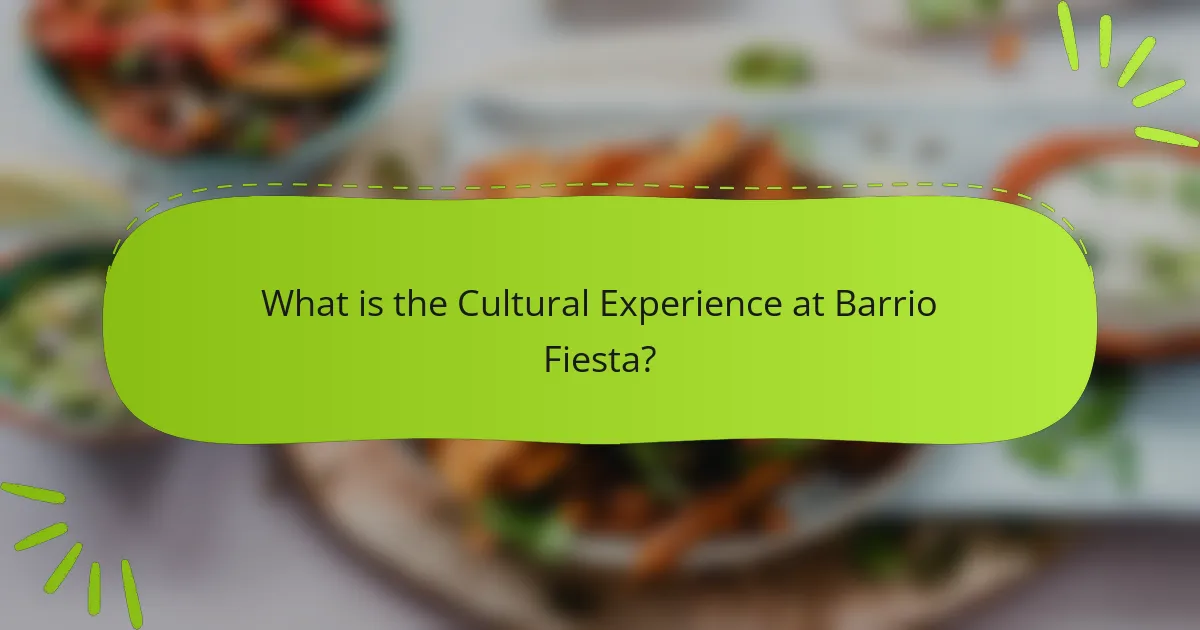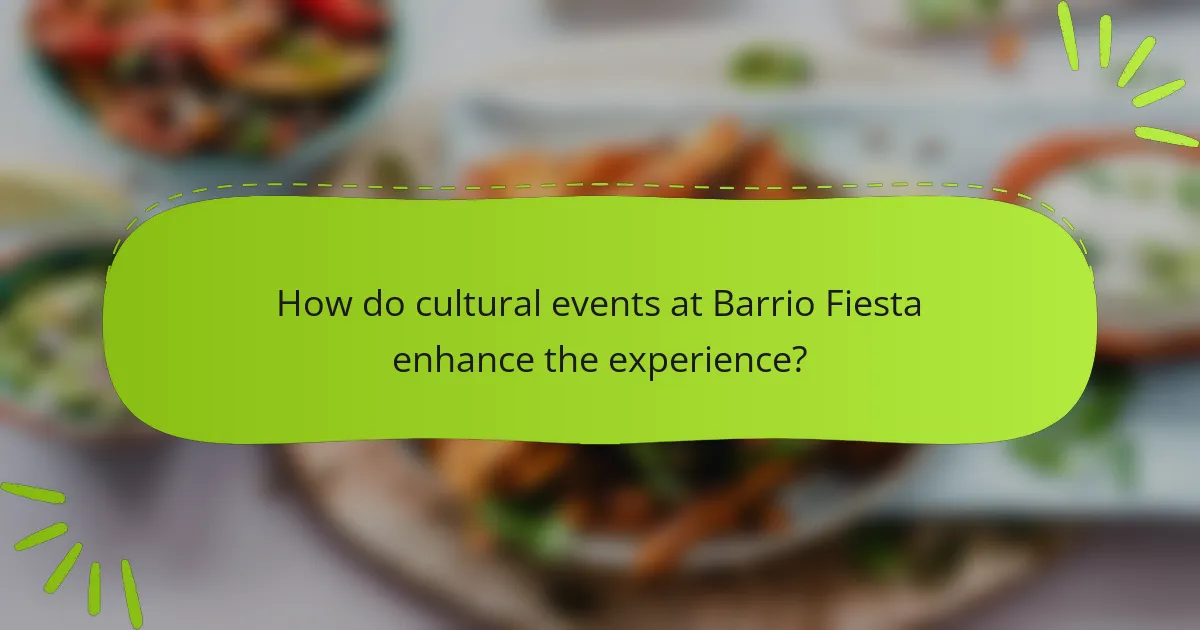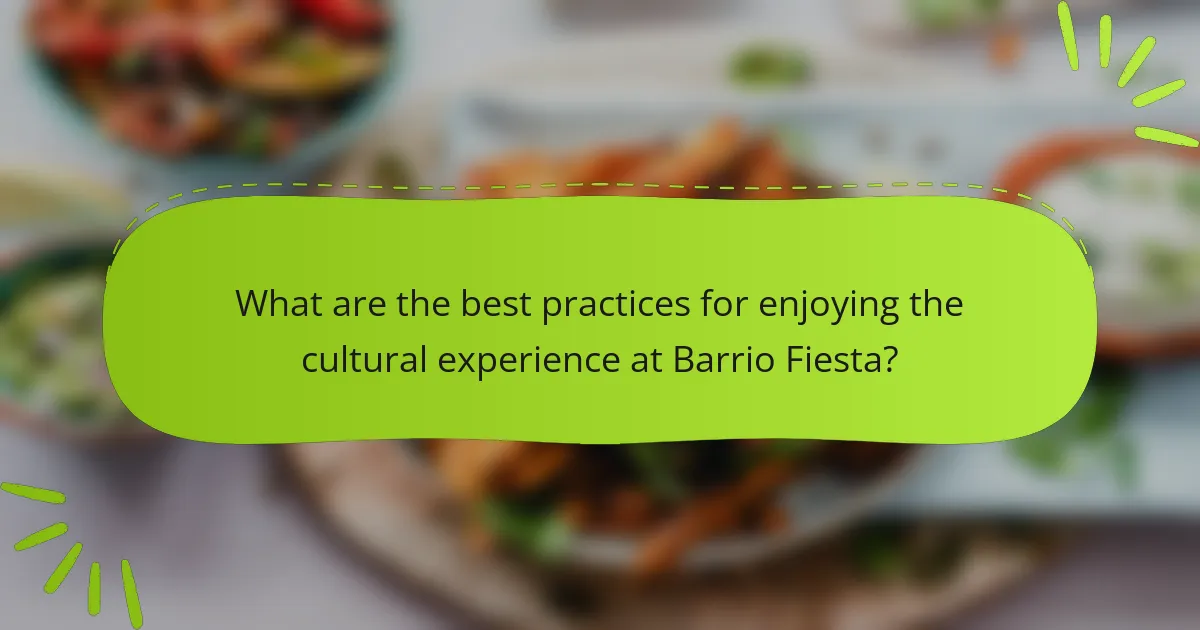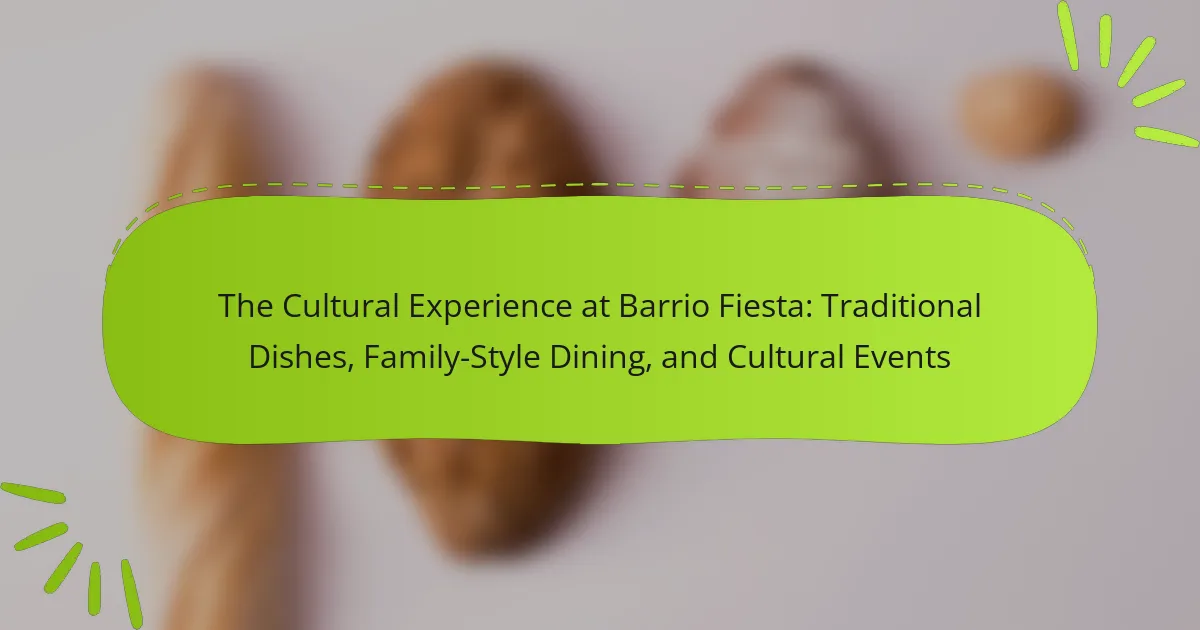Barrio Fiesta is a cultural hub that celebrates Filipino traditions through its cuisine and communal dining experiences. The establishment features traditional dishes served family-style, promoting sharing and togetherness among diners. Cultural events, including dance performances and music, enhance the festive atmosphere and provide immersive engagement with Filipino heritage. Attendees can participate in workshops to learn about traditional crafts and cooking techniques, fostering community connections and cultural appreciation. This vibrant setting attracts visitors seeking an authentic experience of Filipino culture.

What is the Cultural Experience at Barrio Fiesta?
The cultural experience at Barrio Fiesta centers around Filipino traditions and cuisine. It features traditional dishes that reflect the rich heritage of the Philippines. Diners often enjoy family-style dining, promoting communal eating and sharing. This setting fosters a sense of togetherness and celebration. Cultural events, such as dance performances and music, enhance the atmosphere. These events showcase Filipino artistry and customs. Barrio Fiesta serves as a vibrant hub for cultural exchange. It attracts visitors seeking an authentic taste of Filipino culture.
How does Barrio Fiesta celebrate cultural traditions?
Barrio Fiesta celebrates cultural traditions through its authentic Filipino cuisine and vibrant community events. The restaurant features traditional dishes like adobo, lumpia, and sinigang. These meals reflect the rich culinary heritage of the Philippines. Barrio Fiesta also hosts cultural events, including festivals and dance performances. These events showcase Filipino music and traditional attire. By engaging the community, Barrio Fiesta fosters a sense of belonging and cultural pride. The establishment serves as a gathering place for families to share meals and stories. This approach strengthens cultural ties among patrons and preserves Filipino traditions.
What are the key elements of the cultural experience?
The key elements of the cultural experience include traditional dishes, family-style dining, and cultural events. Traditional dishes provide a taste of heritage and culinary practices. They often reflect regional ingredients and historical influences. Family-style dining emphasizes communal eating and fosters connection among participants. This style encourages sharing and interaction, enhancing the overall experience. Cultural events showcase music, dance, and art, highlighting the community’s traditions. These events often involve participation from attendees, creating an immersive atmosphere. Collectively, these elements contribute to a rich cultural tapestry that engages all senses.
How does the ambiance contribute to the overall experience?
The ambiance significantly enhances the overall experience at Barrio Fiesta. It creates a welcoming atmosphere that reflects Filipino culture. Traditional decor, music, and lighting evoke a sense of authenticity. This immersive environment encourages guests to engage with the dining experience. Studies show that ambiance influences customer satisfaction and emotional connection. A positive ambiance can lead to longer visits and increased spending. In this context, Barrio Fiesta’s ambiance fosters a communal dining experience. It invites families and friends to enjoy traditional dishes together.
What traditional dishes are featured at Barrio Fiesta?
Barrio Fiesta features traditional Filipino dishes. Popular offerings include adobo, a savory chicken or pork dish marinated in vinegar and soy sauce. Another staple is sinigang, a sour soup often made with pork and tamarind. Lechon, or roasted pig, is a centerpiece at many celebrations. Pancit, a noodle dish, represents long life and is commonly served at gatherings. Kare-kare, a peanut stew usually made with oxtail, is also featured. These dishes reflect Filipino culinary heritage and are often enjoyed in a family-style dining setting.
What are the most popular traditional dishes served?
The most popular traditional dishes served include adobo, sinigang, and lechon. Adobo is a savory dish made with meat marinated in vinegar, soy sauce, and spices. Sinigang is a sour soup typically made with tamarind and various meats or seafood. Lechon is a whole roasted pig, known for its crispy skin and tender meat. These dishes are staples in Filipino cuisine and are often featured in cultural celebrations. Their popularity is rooted in both flavor and cultural significance.
How are these dishes prepared and presented?
Dishes at Barrio Fiesta are prepared using traditional cooking methods. Ingredients are often sourced locally, emphasizing freshness and authenticity. Common techniques include grilling, stewing, and frying, which enhance flavors. Presentation is typically vibrant and communal, reflecting Filipino culture. Dishes are often served in large platters for sharing. Colorful garnishes and side dishes complement the main offerings. This style encourages family-style dining and interaction among guests. The presentation aims to create a festive atmosphere, celebrating Filipino heritage.
What is family-style dining at Barrio Fiesta?
Family-style dining at Barrio Fiesta is a communal eating experience. It emphasizes sharing large portions of food among diners. Guests typically sit around a table and enjoy a variety of traditional Filipino dishes. This dining style promotes interaction and connection among family and friends. The atmosphere is warm and inviting, encouraging conversation. Barrio Fiesta’s family-style dining experience reflects Filipino culture and hospitality. It creates a sense of togetherness during meals. This approach to dining enhances the overall cultural experience at Barrio Fiesta.
How does family-style dining enhance the cultural experience?
Family-style dining enhances the cultural experience by promoting communal eating and interaction. This dining format encourages sharing dishes, fostering connection among participants. It reflects cultural traditions where meals are a social event. Family-style dining allows guests to sample various traditional dishes, deepening their understanding of the cuisine. This approach also encourages storytelling and cultural exchange during meals. By engaging with others, diners gain insights into cultural values and practices. Overall, family-style dining creates a more immersive and enriching cultural experience.
What are the benefits of sharing meals in this setting?
Sharing meals in this setting fosters community and strengthens relationships. It creates an atmosphere of connection among participants. When meals are shared, individuals experience a sense of belonging. This practice encourages communication and interaction, enhancing social bonds. Studies show that communal dining can improve mental well-being by reducing feelings of isolation. Additionally, sharing meals allows for the exchange of diverse culinary traditions. This enriches the cultural experience and promotes appreciation for different backgrounds. Overall, sharing meals contributes to a vibrant and inclusive environment.

How do cultural events at Barrio Fiesta enhance the experience?
Cultural events at Barrio Fiesta enhance the experience by providing immersive engagement with Filipino traditions. These events showcase traditional music, dance, and art. Participants gain a deeper understanding of Filipino culture through live performances. Interactive workshops allow attendees to learn traditional crafts and cooking techniques. The vibrant atmosphere fosters community bonding among attendees. These cultural events create memorable experiences that resonate with visitors. A study by the Philippine Institute of Culture highlights the importance of cultural events in promoting heritage. This engagement reinforces cultural pride and appreciation among participants.
What types of cultural events are hosted at Barrio Fiesta?
Barrio Fiesta hosts various cultural events that celebrate Filipino heritage. These events include traditional dance performances, music showcases, and culinary festivals. Attendees can experience folk dances like Tinikling and Singkil. Live music performances often feature traditional instruments and contemporary Filipino artists. Culinary events highlight regional dishes and cooking demonstrations. Barrio Fiesta also organizes cultural workshops for crafts and art. These events aim to educate attendees about Filipino culture. They provide an immersive experience for families and communities.
How do these events reflect Filipino culture?
Filipino cultural events reflect the values of community, family, and tradition. These events often emphasize the importance of gathering and sharing meals, showcasing the Filipino practice of family-style dining. Celebrations feature traditional dishes that highlight regional cuisines and culinary heritage. Additionally, cultural performances during these events express Filipino artistry and storytelling. Festivals often incorporate rituals that honor ancestors and religious beliefs, reinforcing spiritual connections. The communal spirit is evident as attendees participate in games and activities, fostering social bonds. Overall, these events serve as a vibrant representation of Filipino identity and collective memory.
What role do performances play in the cultural experience?
Performances are integral to the cultural experience as they convey traditions and values. They serve as a medium for storytelling and expression. Through music, dance, and theater, audiences connect with their heritage. This connection fosters community and shared identity. Performances also educate participants about cultural history. For instance, traditional dances often illustrate historical events or folklore. Events like Barrio Fiesta highlight these performances, enriching the overall cultural experience. They create an engaging atmosphere that promotes cultural appreciation and understanding.
How does the community engage with Barrio Fiesta’s cultural offerings?
The community engages with Barrio Fiesta’s cultural offerings through active participation in various events and family-oriented dining experiences. These events often showcase traditional Filipino music, dance, and culinary practices. Community members attend cultural festivals hosted by Barrio Fiesta, which promote Filipino heritage. Additionally, family-style dining encourages communal sharing of traditional dishes, enhancing social bonds. Feedback from attendees often highlights the sense of belonging fostered by these cultural experiences. The consistent turnout at events indicates strong community support and interest in preserving cultural traditions.
What feedback do visitors provide about their experiences?
Visitors provide overwhelmingly positive feedback about their experiences at Barrio Fiesta. Many highlight the authenticity of traditional dishes, noting their rich flavors and cultural significance. Guests appreciate the family-style dining atmosphere, which fosters a sense of community and togetherness. Visitors frequently mention the vibrant cultural events, praising the engaging performances and interactive activities. Some feedback emphasizes the welcoming staff, who enhance the overall experience with their hospitality. Overall, the combination of food, atmosphere, and cultural engagement creates memorable experiences for visitors.
How do cultural events foster community connection?
Cultural events foster community connection by bringing people together to celebrate shared heritage. These gatherings create a sense of belonging among participants. They encourage interaction through activities like music, dance, and food. Participants often share personal stories and traditions, strengthening bonds. Research shows that community events enhance social networks and reduce feelings of isolation. For example, a study by the National Endowment for the Arts found that attending arts events significantly increases community engagement. This engagement leads to improved local collaboration and support. Overall, cultural events serve as a vital platform for building relationships within the community.

What are the best practices for enjoying the cultural experience at Barrio Fiesta?
To enjoy the cultural experience at Barrio Fiesta, immerse yourself in the local traditions. Participate in traditional dances and music performances to appreciate the cultural richness. Engage with local vendors to learn about authentic Filipino dishes. Savor the food by trying various traditional dishes served family-style. Attend cultural events and workshops to gain deeper insights into Filipino heritage. Interact with the community to foster connections and share experiences. Arrive early to fully experience the festivities and avoid missing key events. Lastly, respect local customs and practices to enhance your cultural appreciation.
How can visitors make the most of their visit?
Visitors can make the most of their visit by planning ahead. Research the menu options to choose traditional dishes that appeal to your taste. Arrive early to secure a good table for family-style dining. Engage with staff to learn about cultural events happening during your visit. Participate in any scheduled activities to enhance your experience. Take time to appreciate the ambiance and decor that reflect cultural heritage. Share dishes with companions to enjoy a variety of flavors. Finally, consider visiting during peak cultural events for a richer experience. These strategies can lead to a memorable visit.
What tips should guests consider when trying traditional dishes?
Guests should be open-minded when trying traditional dishes. Embracing new flavors enhances the dining experience. Understand the cultural significance of the dish being served. Many traditional dishes reflect historical or regional contexts. Ask questions about the ingredients and preparation methods. This can deepen appreciation for the cuisine. Consider sharing dishes family-style to promote communal dining. Sharing encourages interaction and exploration of various flavors. Lastly, be respectful of cultural dining customs. Following local etiquette shows appreciation for the tradition.
How can families enhance their dining experience together?
Families can enhance their dining experience together by engaging in meaningful conversations during meals. This fosters connection and understanding among family members. Setting a specific dining schedule can also create a routine that everyone looks forward to. Research indicates that regular family meals contribute to better emotional well-being. Involving everyone in meal preparation encourages teamwork and shared responsibility. Families can explore traditional recipes, which can deepen cultural appreciation. Additionally, creating a pleasant atmosphere with music or decorations can elevate the dining experience. Dining together without distractions, such as phones or television, promotes focused interactions.
The main entity of the article is Barrio Fiesta, which focuses on the cultural experience surrounding Filipino traditions and cuisine. The article outlines key elements such as traditional dishes, family-style dining, and cultural events that foster community engagement and cultural pride. It highlights popular dishes like adobo, sinigang, and lechon, and emphasizes the importance of communal eating and interactive cultural performances. Additionally, the article discusses how the ambiance enhances the dining experience and offers best practices for visitors to fully immerse themselves in Filipino culture.
